Jochen Schröder
Blind Frequency-Domain Equalization Using Vector-Quantized Variational Autoencoders
Dec 26, 2023


Abstract:We propose a novel frequency-domain blind equalization scheme for coherent optical communications. The method is shown to achieve similar performance to its recently proposed time-domain counterpart with lower computational complexity, while outperforming the commonly used CMA-based equalizers.
Real-Time Monitoring of Cable Break in a Live Fiber Network using a Coherent Transceiver Prototype
Jul 03, 2023

Abstract:We monitor a 524km live network link using an FPGA-based sensing-capable coherent transceiver prototype during a human-caused cable break. Post-analysis of polarization data reveals minute-level potential warning precursors and baseline-exceeding changes directly preceding the break.
Blind Channel Equalization Using Vector-Quantized Variational Autoencoders
Feb 22, 2023
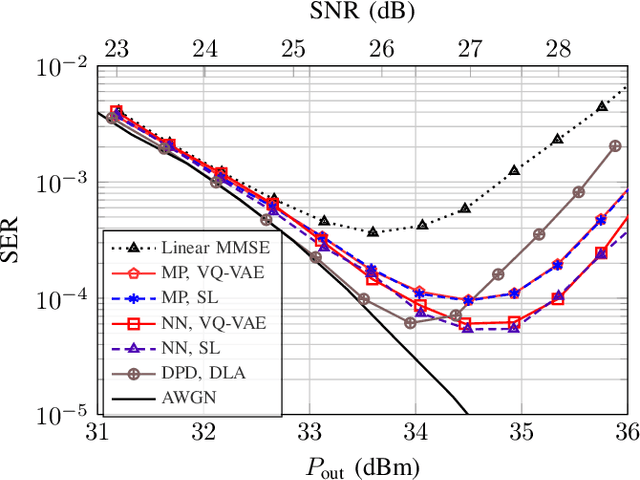


Abstract:State-of-the-art high-spectral-efficiency communication systems employ high-order modulation formats coupled with high symbol rates to accommodate the ever-growing demand for data rate-hungry applications. However, such systems are more vulnerable to linear and nonlinear transmission impairments, and it is important to mitigate the performance loss via digital signal processing. In this paper, we propose a novel machine learning approach for blind channel equalization and estimation using the vector quantized (VQ) \ac{VAE} framework. The proposed approach generalizes the applicability of the conventional \ac{VAE}-based equalizer to nonlinear systems employing high-order modulation formats by introducing a codebook component and an associated novel loss function. We evaluate the performance of the proposed method over a linear additive white Gaussian noise channel with intersymbol interference and two nonlinear scenarios. Simulation results show that the proposed method can achieve similar performance as a data aided equalizer using the \acf{MMSE} criterion, and outperforms the blind\ac{CMA} and the \ac{VAE}-based channel equalizer. Furthermore, we show that for the linear channel, the proposed scheme exhibits better convergence properties than the \ac{MMSE}-based, the \ac{CMA}-based, and the \ac{VAE}-based equalizers in terms of both convergence speed and robustness to variations in training batch size and learning rate.
Benchmarking and Interpreting End-to-end Learning of MIMO and Multi-User Communication
Mar 15, 2022
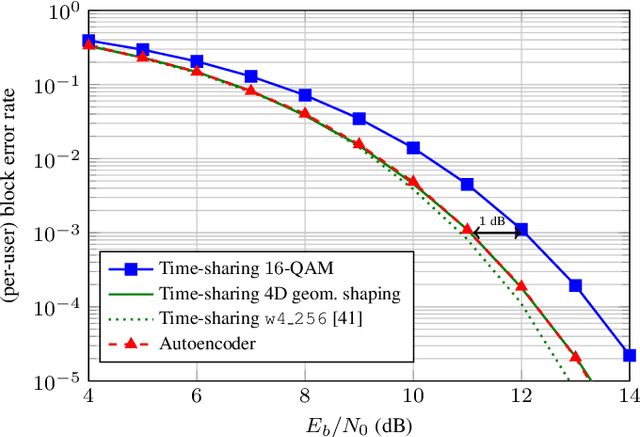
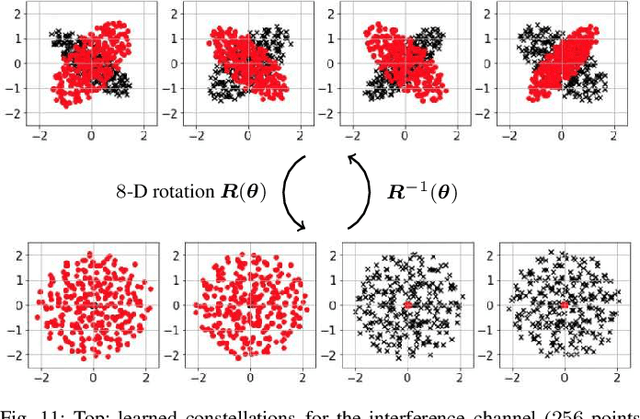

Abstract:End-to-end autoencoder (AE) learning has the potential of exceeding the performance of human-engineered transceivers and encoding schemes, without a priori knowledge of communication-theoretic principles. In this work, we aim to understand to what extent and for which scenarios this claim holds true when comparing with fair benchmarks. Our particular focus is on memoryless multiple-input multiple-output (MIMO) and multi-user (MU) systems. Four case studies are considered: two point-to-point (closed-loop and open-loop MIMO) and two MU scenarios (MIMO broadcast and interference channels). For the point-to-point scenarios, we explain some of the performance gains observed in prior work through the selection of improved baseline schemes that include geometric shaping as well as bit and power allocation. For the MIMO broadcast channel, we demonstrate the feasibility of a novel AE method with centralized learning and decentralized execution. Interestingly, the learned scheme performs close to nonlinear vector-perturbation precoding and significantly outperforms conventional zero-forcing. Lastly, we highlight potential pitfalls when interpreting learned communication schemes. In particular, we show that the AE for the considered interference channel learns to avoid interference, albeit in a rotated reference frame. After de-rotating the learned signal constellation of each user, the resulting scheme corresponds to conventional time sharing with geometric shaping.
Model-Based End-to-End Learning for WDM Systems With Transceiver Hardware Impairments
Nov 29, 2021
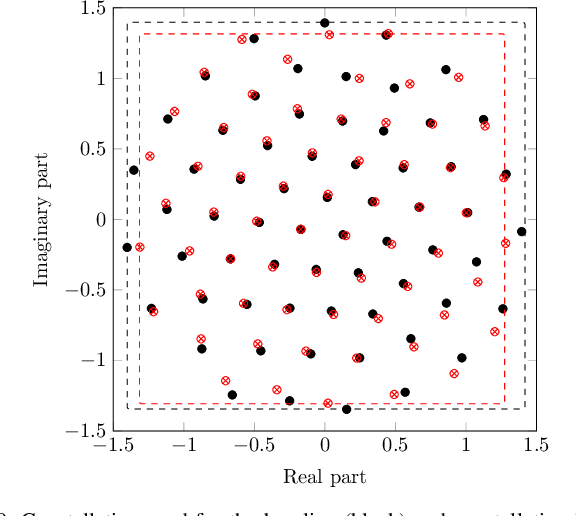
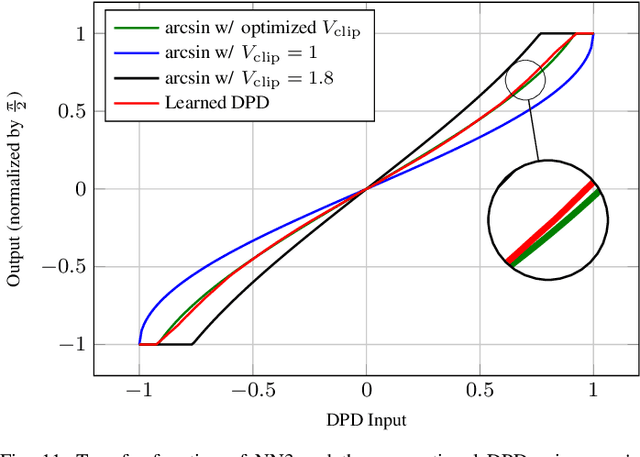
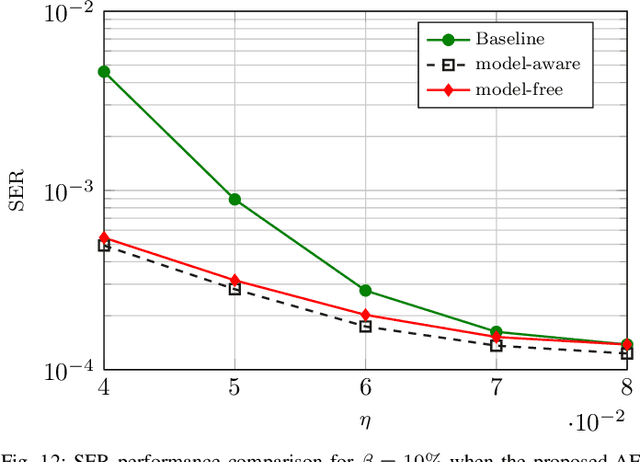
Abstract:We propose an AE-based transceiver for a WDM system impaired by hardware imperfections. We design our AE following the architecture of conventional communication systems. This enables to initialize the AE-based transceiver to have similar performance to its conventional counterpart prior to training and improves the training convergence rate. We first train the AE in a single-channel system, and show that it achieves performance improvements by putting energy outside the desired bandwidth, and therefore cannot be used for a WDM system. We then train the AE in a WDM setup. Simulation results show that the proposed AE significantly outperforms the conventional approach. More specifically, it increases the spectral efficiency of the considered system by reducing the guard band by 37\% and 50\% for a root-raised-cosine filter-based matched filter with 10\% and 1\% roll-off, respectively. An ablation study indicates that the performance gain can be ascribed to the optimization of the symbol mapper, the pulse-shaping filter, and the symbol demapper. Finally, we use reinforcement learning to learn the pulse-shaping filter under the assumption that the channel model is unknown. Simulation results show that the reinforcement-learning-based algorithm achieves similar performance to the standard supervised end-to-end learning approach assuming perfect channel knowledge.
Over-the-fiber Digital Predistortion Using Reinforcement Learning
Jun 09, 2021

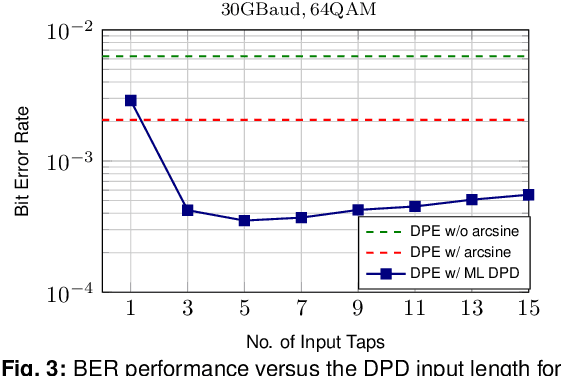
Abstract:We demonstrate, for the first time, experimental over-the-fiber training of transmitter neural networks (NNs) using reinforcement learning. Optical back-to-back training of a novel NN-based digital predistorter outperforms arcsine-based predistortion with up to 60\% bit-error-rate reduction.
Power Efficient Communication for Low Signal to Noise Ratio Optical Links
Apr 20, 2021


Abstract:Receiver sensitivity is a particularly important metric in optical communication links operating at low signal-to-noise ratios (SNRs), for example in deep-space communication, since it directly limits the maximum achievable reach and data rate. Pulse position modulation (PPM) with direct detection photon-counting detectors are the most power-efficient solution known, however, the sensitivity gain comes at the expense of reduced spectral efficiency. We show that quadrature phase-shift keying (QPSK) modulation with a phase-sensitive ultralow noise pre-amplified coherent receiver outperforms other well-known power-efficient multi-dimensional coherent modulation formats, while simultaneously having higher spectral efficiency. It also results in better sensitivity than PPM for orders up to 64 with ideal direct detection using photon-counting receivers. This is because of the bit error rate characteristics favoring the QPSK format when forward error correction with a large overhead is considered.
End-to-end Autoencoder for Superchannel Transceivers with Hardware Impairment
Mar 29, 2021


Abstract:We propose an end-to-end learning-based approach for superchannel systems impaired by non-ideal hardware component. Our system achieves up to 60% SER reduction and up to 50% guard band reduction compared with the considered baseline scheme.
 Add to Chrome
Add to Chrome Add to Firefox
Add to Firefox Add to Edge
Add to Edge